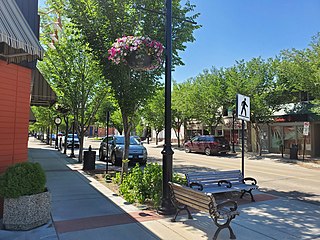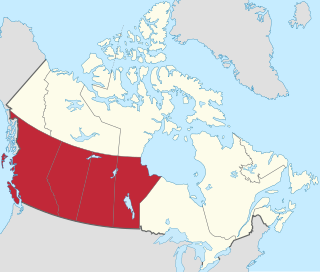Related Research Articles

Lloydminster is a city in Canada which has the unusual geographic distinction of straddling the provincial border between Alberta and Saskatchewan. The city is incorporated by both provinces as a single city with a single municipal administration.

Fort Saskatchewan is a city along the North Saskatchewan River in Alberta, Canada. It is 25 kilometres (16 mi) northeast of Edmonton, the provincial capital. It is part of the Edmonton census metropolitan area and one of 24 municipalities that constitute the Edmonton Metropolitan Region Board. Its population in the 2021 federal census was 27,464.

The 1880 United States census, conducted by the Census Office during June 1880, was the tenth United States census. It was the first time that women were permitted to be enumerators. The Superintendent of the Census was Francis Amasa Walker. This was the first census in which a city—New York City—recorded a population of over one million, and the first census in which the 20 most populated cities all recorded over 100,000 residents.
Statistics Canada conducts a national census of population and census of agriculture every five years and releases the data with a two-year lag.
The 1911 Canadian census was a detailed enumeration of the Canadian population. The census was started on June 1, 1911. All reports had been received by February 26, 1912. The total population count of Canada was 7,206,643. This was an increase of 34% over the 1901 census of 5,371,315.
The 1906 Canadian census was the first of a series of special censuses conducted by the Government of Canada, covering the rapidly expanding Northwest Provinces of Alberta, Saskatchewan, and Manitoba. These censuses were conducted every ten years from 1906 to 1946.

Mankota is a village in the Canadian province of Saskatchewan within the Rural Municipality of Mankota No. 45 and Census Division No. 3. The village is located on Highway 18, about 150 kilometres (93 mi) southeast of the city of Swift Current.
The economy of Saskatchewan has been associated with agriculture resulting in the moniker "Bread Basket of Canada" and Bread Basket of the World. According to the Government of Saskatchewan, approximately 95% of all items produced in Saskatchewan, depend on the basic resources available within the province. Various grains, livestock, oil and gas, potash, uranium, wood and their spin off industries fuel the economy.
Compeer is a hamlet in east-central Alberta, Canada within Special Area No. 4. Previously an incorporated municipality, Compeer dissolved from village status on December 31, 1936, to become part of the Municipal District of Neutral Hills No. 331.

Bellis is a hamlet in central Alberta, Canada within Smoky Lake County. Previously an incorporated municipality, Bellis dissolved from village status on January 1, 1946 to become part of the Municipal District of Vilna No. 575.

Western Canada, also referred to as the Western provinces, Canadian West, or Western provinces of Canada, and commonly known within Canada as the West, is a Canadian region that includes the four western provinces just north of the Canada–United States border namely British Columbia, Alberta, Saskatchewan and Manitoba. The people of the region are often referred to as "Western Canadians" or "Westerners", and though diverse from province to province are largely seen as being collectively distinct from other Canadians along cultural, linguistic, socioeconomic, geographic and political lines. They account for approximately 32% of Canada's total population.
The Canada 1921 census was a detailed enumeration of the Canadian population. The census count was taken as at June 1, 1921. The total population count was 8,788,483 representing a 22% increase over the 1911 census population count of 7,206,643. The 1921 census was the sixth comprehensive decennial census since Canadian Confederation on July 1, 1867. The previous census was the Northwest Provinces of Alberta, Saskatchewan, and Manitoba 1916 census and the following census was the Northwest Provinces of Alberta, Saskatchewan, and Manitoba 1926 census.
The 1926 Canadian census was the third of a series of special censuses conducted by the Government of Canada covering the rapidly expanding Northwest Provinces of Alberta, Saskatchewan, and Manitoba. These censuses were conducted every ten years from 1906 to 1946. This census was conducted as at June 1, 1926.
The 1936 Canadian census was the fourth of a series of special censuses conducted by the Government of Canada covering the rapidly expanding Northwest Provinces of Alberta, Saskatchewan, and Manitoba. These censuses were conducted every ten years from 1906 to 1946. This census was conducted as at June 1, 1936.
The 1946 Canadian census was the fifth, and last, of a series of special censuses conducted by the Government of Canada covering the rapidly expanding Northwest Provinces of Alberta, Saskatchewan, and Manitoba. These censuses were conducted every ten years from 1906 to 1946, and ceased when the nationwide census switched from decennial to quinquennial in 1956. This census was conducted as of June 1, 1946.
The Canada 1931 census was a detailed enumeration of the Canadian population. The census count was taken as at June 1, 1931. The total population count was 10,376,379 representing a 17.9% increase over the 1911 census population count of 8,800,249. The 1931 census was the seventh comprehensive decennial census since Canadian Confederation on July 1, 1867.
The 1951 Canadian census was a detailed enumeration of the Canadian population. The total population count was 14,009,429, representing a 21.8% increase over the 1941 census population count of 11,506,655. The 1951 census was the ninth comprehensive decennial census since Canadian Confederation on July 1, 1867.
The 1901 Canadian census was a detailed enumeration of the Canadian population. The census was started on June 1, 1901. All reports had been received by February 26, 1902. The total population count of Canada was 5,371,315. This was an increase of 11% over the 1891 census of 4,833,239.
The Census of Manitoba (1870), also known as the Archibald Census, was the first census held in the province of Manitoba, and the overall first census that took place on Canadian territory since the Confederation. The census officially took place on October 27, 1870, based on information collected as of July 16 of the same year, and predates the first nationwide census by five months.
References
- ↑ "About the 1916 Census". Library and Archives Canada. January 16, 2013. Retrieved March 14, 2015.